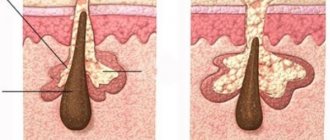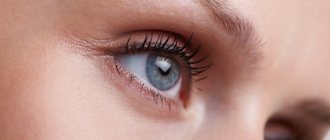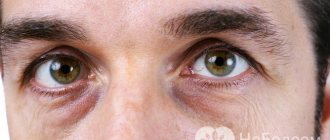Puffy eyes - what is the reason?
Factors that cause swollen eyes are internal and external. External ones include lack of sleep or, on the contrary, prolonged sleep of more than 10 hours, prolonged work at the computer, stress, tears, use of low-quality cosmetics, wearing contact lenses in the wrong way. Alcohol abuse, late dinner, and drinking too much before bed also lead to swelling of the eyes and eyelids. All these reasons are not pathological. There are also internal factors that are associated with diseases of the visual organs or other body systems. In general, eyes become swollen for the following reasons:
- inflammatory eye diseases of an infectious or viral nature:
- eyelid abscess, stye, conjunctivitis, blepharitis, iridocyclitis;
- general infectious or viral diseases: influenza, ARVI;
- allergy;
- oncological eye diseases;
- circulatory disorders;
- injuries to the organs of vision, eye sockets;
- bad habits;
- pathologies of the thyroid gland, pituitary gland, blood vessels, heart, kidneys, liver, gastrointestinal tract;
- pregnancy, which often leads to water-salt imbalance.
Sometimes the cause of swelling is a congenital structural feature of the lower and upper eyelids.
Who is at risk
What factors contribute to the development of kidney disease?
- Primarily alcohol and smoking. Not only adults, but even children know about the dangers of strong drinks and tobacco. Healthy lifestyle courses are taught at school. But not all people rush to go for a run instead of going to a restaurant. And every drink you drink or cigarette puff is a source of toxins. Cleansing the body of toxic impurities, the kidneys work hard.
- The chances of being in a risk group increase with sudden weight loss. Excessive adherence to strict diets leaves the kidneys without a fat layer. And although diets are aimed at combating subcutaneous fat, the body receives energy to maintain vital functions during hunger strikes by breaking down, first of all, internal fat. The protective shell becomes thin and no longer protects against the harmful effects of external factors.
- Not only sudden weight loss is harmful, but also excessive obesity. With excess weight, pressure on the kidneys increases, hormones are produced that affect vascular tone, and metabolism slows down.
- Increased pressure affects the blood vessels of the kidneys and gradually leads to their destruction.
- Diabetes. Increased sugar increases the load on the body; intensive work excessively depletes the kidneys.
- The cause of pyelonephritis is often hypothermia. The disease is accompanied by characteristic symptoms (discomfort when urinating, lower back pain, temperature), thanks to which it is easily diagnosed.
- Excessive indulgence in fried, salty, fatty or smoked foods leads to swelling. Unsanitary conditions increase the likelihood of viral infections, complications affecting the kidneys.
- Climate also affects the smooth functioning of the body. Drying heat or severe frosts can cause diseases of the urinary system. According to statistics, people living in the south or northern regions are more likely to get sick.
Why does the child's eyelid and under the eyes suddenly swell?
It is not entirely correct to divide the causes of swelling under the eyes into “children” and “adults”. However, there are more common ones:
- Injuries. This is the most common reason why a child's eyes become swollen. Children spend most of their time playing; they can accidentally fall or fight if they don’t share something. Contusions are usually accompanied by bruises.
- A bite of an insect. The area affected by an insect (mosquito, gadfly, bedbug, etc.) usually itches and turns red.
- Phlegmon of the orbit is a purulent inflammation that manifests itself in symptoms such as nausea, vomiting, migraine, blurred vision, eyelid hyperemia, pain when moving the eyes.
- Abscess of the lacrimal sac. In this pathological condition, pus and a large amount of tear fluid are released from the eyes. The eyelids become swollen and red. The child instinctively rubs them with his hands, which causes the swelling to increase and cause even more discomfort.
- Quincke's edema is an allergic disease that causes severe swelling. They usually occur on the legs, arms and face. The color of the skin does not change, there is no itching. Sometimes the patient experiences nausea and vomiting.
Why are the eyelids prone to puffiness?
To understand why swelling on the face most often appears in the area of the upper and lower eyelids, you need to consider certain physiological and anatomical features of this area:
- the vascular network is very well developed, has dense branching, which in itself contributes to the influx of a large amount of blood and the formation of swelling;
- the skin of the eyelids and loose subcutaneous tissue form a large space for retaining fluid in the tissues;
- lack of dense fatty tissue in the thickness of the eyelids;
- this anatomical area has very few collagen and elastin fibers;
- the eyelids are subject to constant stress when blinking;
- the tightly attached skin of the forehead, nose and cheeks prevents fluid from accumulating under them, as a result of which it moves to the free adjacent area - the upper and lower eyelids.
Due to the anatomical structure of the eyelids, this area of the face is most prone to swelling
The upper eyelid is swollen: causes
Both eyelids or just the upper eyelid may swell. Usually one of them is affected by allergies and inflammation. In this case, the cause is usually inflammatory diseases of internal organs. Often the upper eyelid swells due to age-related physiological changes. The thin membrane located between the subcutaneous tissue and the skin of the eyelid cannot retain fluid. This leads to swelling of the eyelid.
Causes of kidney swelling
It is worth understanding that it is edema and swelling of the face/arms/legs that are the first signs of poor kidney function. And if they are additionally loaded in the evening with a large amount of liquid, alcohol or salty food, then the morning picture will not please them at all. Since facial puffiness is one of the clinical signs of nephrotic syndrome in the following pathologies of the urinary organs:
- Pyelonephritis. Simply put, an inflammatory process in the calyx-pelvic region of the kidneys. As a rule, it develops against the background of a previous viral infection. In this case, bacteria/Escherichia coli, etc. penetrate the kidneys, where they stimulate the inflammatory process. The pathology can occur quite latently with unexpressed symptoms, which are often interpreted as tired person syndrome.
- Glomerulonephritis. Or inflammation of the glomerular apparatus of the kidneys. It develops as an independent disease after suffering from hypothermia. In this case, the kidneys simply do not have time to filter the blood, which leads to excessive swelling.
- Benign and malignant formations in the kidneys. Growing in the kidney parenchyma, such tissues compress the vessels of the urinary organs (nephrons), which leads to a decrease in kidney function.
- Nephropathy of pregnancy. In expectant mothers, the growth of the fetus and uterus moves the kidneys up or down relative to their normal position. In this case, the urinary tract and ureters become overloaded, making it difficult to evacuate urine. Accordingly, fluid is retained in the body.
- Toxic nephropathy. Or simply severe poisoning of the body with toxic substances, which leads to kidney failure. At risk are alcoholics and drug addicts, people working in chemical and toxic industries.
In addition, it is worth understanding that nephrotic syndrome (namely reduced kidney function) can also develop as a pathology concomitant with other diseases. These are:
- Heart failure;
- Liver failure;
- Problems with blood vessels;
- Autoimmune processes in the body;
- Viral infections;
- Diseases of the lymphatic system;
- Urolithiasis disease.
What causes the lower eyelid to swell?
As a rule, with such swelling, bags appear under the eyes and they usually appear on both sides. The reasons for this may be the following:
Poor lifestyle, unbalanced diet, injuries, use of low-quality cosmetics, lack of hygiene. These factors are isolated and are not associated with diseases. Diseases of blood vessels, kidneys, heart, thyroid gland, allergies, fatty hernia, congenital and age-related features of the structure of the eyes.
Swelling that does not go away during the day and is not accompanied by any symptoms usually indicates the presence of a fatty hernia. They most often occur in women over 35 and are associated with aging, which causes the skin to become less elastic.
The causes of swelling under the eyes can be listed further. Basically, this symptom is not dangerous. In the morning a person wakes up and sees that his eye (or both) is swollen, and by evening the swelling goes away on its own. Men usually do not pay attention to such a cosmetic defect. It mainly bothers women who try to disguise it with cosmetics. Sometimes it is necessary to consult a doctor to find out the exact cause of swelling. The need for this arises with chronic swelling.
Swelling around the eyes as a sign of disease
If edema occurs regularly, is persistent or recurrent, is pronounced, and is accompanied by other pathological symptoms, then there is a very high probability that they are one of the signs of some disease. Therefore, it is very important to seek help from a specialist as early as possible in order to establish the cause in time and prescribe effective treatment.
Eye diseases
There are a lot of eye diseases that can be accompanied by swelling of the affected organ. If the pathological process is bilateral, then both eyes swell. Such lesions include infectious and inflammatory diseases (conjunctivitis, blepharitis, scleritis, uveitis, barley, dacryocystitis), injuries and foreign bodies, malignant and benign neoplasms, chemical and thermal burns, allergic reactions.
An ophthalmologist will help determine the exact reason why your eyes swell. Upon examination, the specialist will determine whether the swelling is caused by an ophthalmic disease or other factors.
With conjunctivitis, in addition to swelling, a person is bothered by itching, burning, pain in the eye, redness and pathological discharge, even visual acuity may be impaired
Allergic reaction
One of the most common symptoms of an immediate allergic reaction is swelling of the eyelids above the eyes, as well as the area around the lips. This type of edema is also called Quincke's edema; it refers to conditions that require immediate medical attention, as they threaten human health and life. Along with swelling, redness, itching and rash may occur.
The cause of Quincke's edema can be any allergen (cosmetics, food, medications, inhalation substances, poison from insect bites, etc.). Allergic swelling occurs immediately after exposure to the causative factor for 5–30 minutes. Almost always such swelling is bilateral.
Every person with angioedema requires hospitalization, as this dangerous condition can lead to swelling of the larynx and acute respiratory failure
Kidney diseases
If your lower eyelids are constantly swollen in the morning, you need to rule out the presence of chronic kidney disease. Renal edema occurs when a person develops nephrotic or nephritic syndrome against the background of an underlying chronic pathology (glomerulonephritis, pyelonephritis, interstitial nephritis, chronic renal failure, etc.).
Characteristic features of edema in kidney diseases:
- appear first on the face (in the area of the lower eyelids), then spread to the entire face, which becomes puffy; if the pathological process is not stopped, the swelling descends lower and can affect the entire body (anasarca);
- the skin over the swelling is pale and warm to the touch;
- the swelling is loose, tends to change localization, that is, in the morning after sleep they are observed around the eyes, and in the evening they can fall to the ankles and hands.
Characteristic appearance of a person with morning puffiness under the eyes
Important! There are cases when swelling is the only symptom of kidney disease. Therefore, you should not ignore such manifestations, but you should seek help from a doctor as soon as possible, even if you are not bothered by any other pathological signs.
Cardiovascular diseases
Any damage to the cardiovascular system that has led to the development of congestive heart failure may manifest itself as swelling. A feature of cardiac edema is its localization: it appears at the end of the day in the area of the ankle joints, but with decompensation of the disease, the edema can rise upward and affect the face and the area around the eyes.
As a rule, the skin over such formations has a bluish tint, is cold to the touch, and when pressed with a finger, an indentation remains (as in a dough). In addition to what is described, the patient experiences the main symptoms of cardiovascular pathology: shortness of breath, pain in the heart, increased or decreased blood pressure, heart rhythm disturbances, and general weakness.
Thyroid diseases
If you have persistent swelling of the eyelids, then you need to check the condition of the thyroid gland. Reduced function of this organ (hypothyroidism) may be accompanied by the development of such a symptom. In this case, the iron does not produce sufficient quantities of the hormones T3 and T4 (triiodothyronine and thyroxine). The manifestations of this dangerous pathology, unfortunately, are nonspecific. For a long time, a person complains of increased fatigue, general weakness, drowsiness, decreased memory and ability to concentrate on something, hair loss, dryness and flaking of the skin. Women may experience menstrual irregularities, infertility, and a hoarse voice.
Also, characteristic swelling often appears in the periorbital area (around the eyes), it is dense to the touch, has a jelly-like consistency, when pressing with a finger on the swelling area, the indentation does not remain, it is permanent (that is, it does not occur in the morning or at night, but is observed throughout the day), do not improve with treatment with diuretics.
Other manifestations of this disease will help to recognize edema in hypothyroidism.
Sinusitis
A very common symptom of inflammation of the maxillary paranasal sinus (maxillary sinus) is swelling of the periorbital zone, which indicates an advanced pathological process and the possible development of complications.
The maxillary sinuses are located in close proximity to the orbit. This contributes to the spread of infection and the inflammatory process to the fatty tissue and the development of swelling, first at the site of the projection of the maxillary paranasal sinus, and then higher (lower eyelids).
The following symptoms will help you suspect the disease:
- severe headache of a throbbing nature, which intensifies with the slightest movements;
- difficult nasal breathing;
- mucous, purulent and bloody discharge from the nasal cavity with an unpleasant putrefactive odor.
- In this case, systemic antibacterial therapy is indicated, and the question of the advisability of surgical treatment of purulent sinusitis must be individually considered.
Swelling around the eyes with sinusitis indicates a high likelihood of complications.
Intervertebral hernia of the cervical spine
Almost all the symptoms that occur in a person with a cervical herniated disc are associated with compression (squeezing) of blood vessels and nerve trunks by this formation. Swelling of the face and periorbital area may also occur in such people. Associated with difficulty in venous and lymphatic drainage from the head due to a large hernial protrusion of the damaged intervertebral disc.
The accompanying symptoms characteristic of an intervertebral hernia of the cervical spine will help you suspect a problem:
How to remove puffiness from eyes
- constant aching pain in the neck and shoulder girdle (cervicalgia);
- acute pain in the neck that occurs from time to time (cervicago);
- headache and dizziness;
- numbness in the hands;
- ringing in the ears, spots before the eyes;
- crunching in the neck during movements;
- fluctuations in blood pressure, heart rhythm disturbances, pain in the heart area.
Injuries
Swelling after injury to the structures of the eye, as well as parts of the facial skeleton, almost always occurs. One side may be affected or both eye sockets may be affected. Such swelling is first red and then bluish, as it is caused by the accumulation of blood (hematoma) in the loose tissues of the periorbital region.
Swelling and hematoma of the left eye due to trauma
A minor hematoma may disappear on its own, but a large accumulation of blood requires surgical intervention. Because it can cause complications.
Insect bites
Severe swelling of the periorbital area can be caused by an insect bite (wasp, bee, midge, mosquito, flea, etc.). As a rule, such a strong reaction to a bite is observed in children, as well as in adults who are sensitized to the components of the venom or saliva of a certain insect.
Children are prone to a hyperergic (pronounced) reaction to insect bites
Gestosis during pregnancy
If a pregnant woman suddenly experiences swelling in any part of the body, including around the eyes, be sure to consult a doctor (obstetrician-gynecologist) as soon as possible. The fact is that swelling is one of the main symptoms of a pregnancy complication that is dangerous for both the mother and the fetus - late gestosis. This condition is characterized by three main manifestations - edema, increased blood pressure and the appearance of protein in a urine test.
Unfortunately, today the true causes of the development of gestosis have not been fully established. This condition complicates approximately 25–30% of pregnancies; the risk of developing the pathology is higher during the first pregnancy.
The development of gestosis negatively affects the health of the woman and child. The pathology can lead to premature birth, placental abruption, acute fetal hypoxia, and intrauterine death. Preeclampsia also increases the risk of developing dangerous hemorrhages in the vital organs of a pregnant woman and causes convulsive syndrome (eclampsia), which can be fatal for both the mother and the unborn child.
Eyelids and eyes are swollen: what to do?
The method of eliminating this symptom depends on the cause of its occurrence. If this is an infectious ophthalmological disease, eye drops, ointments and gels are prescribed. When a disease of the internal organs leads to swelling of the eyes, one has to take steroids, anti-allergenic drugs and drugs that improve blood circulation.
In any case, the underlying pathology is always treated.
For eye pathologies accompanied by itching, hyperemia and burning in the eyes, the following drops are prescribed:
- "Sulfacyl". It helps with blepharitis and conjunctivitis.
- "Albucid" - drops with an antibacterial effect, prescribed for conjunctivitis and keratitis.
- "Floxal" is an antimicrobial drug that is most often used for corneal ulcers, eye injuries, and barley.
- "Allergodil" is an ophthalmic solution that relieves itching, redness and swelling.
You cannot use medications without a prescription. Puffiness of the eyelids, bags and bruises under the eyes are quite common symptoms characteristic of many diseases. You will not be able to make a diagnosis on your own.
Using the drug for other purposes may lead to complications.
Ointments and gels are used in addition to drops. Tetracycline, hydrocortisone, heparin or oxolinic ointment helps eliminate swelling under the eyes and on the eyelids.
Cosmetology procedures
Cosmetology has many new methods that help get rid of puffiness under the eyes. It is worth noting that they are really effective, but the effect of the procedures does not last long, and you have to repeat them again and again. It’s not for nothing that they say that if you visit a cosmetologist at least once, you will return to him more than once.
- Mesotherapy
Mesotherapy in the eye area (mesh method or back-trace method) is a procedure for introducing various drugs (vitamin complexes, amino acids, homeopathic compounds) under the skin or inside the skin. It is necessary to repeat the course of procedures up to 8-10 times once a week.
- Cryolifting
Cryolifting of problem areas is a targeted and short-term exposure to cold, bringing tissue cells into a stressful state and forcing them to activate metabolic processes, incl. remove excess liquid. The method has good reviews and has virtually no contraindications.
Folk remedies for relieving swelling
So-called traditional medicine can be used in the treatment of infectious diseases, but after consultation with a specialist. You can take note of the following recipes:
- Green tea. Brew it, cool it, pour it into ice trays and put it in the freezer. Apply ice cubes to your eyelids every morning for 1-2 minutes. Brewed bags can be used as lotions. They should be applied to the eyelids for 10-15 minutes.
- Grated potatoes. Peel it raw and grate it on a fine grater. After that, put it in cheesecloth and squeeze out the juice. You need to blot the cotton wool in it and apply it to your closed eyes.
- Oak bark. It is infused in hot water. After this, strain the liquid and use it to make lotions. Instead of oak bark, you can make infusions from various herbs, such as chamomile.
Face masks are made from vegetables, sour cream, fruits, etc. There are special masks that are sold in pharmacies. If you have time and sufficient financial resources, contact a cosmetologist. Such measures allow you to eliminate swelling quickly, but, of course, do not affect the reasons that lead to its appearance.
Diagnostics
When a patient complains of swelling of the face, the attending physician will definitely prescribe a number of measures aimed at identifying the pathology. So, the main ones are:
- General urine analysis. Here, the main signs of a kidney problem will be an increased level of white blood cells, protein and possibly red blood cells.
- General blood analysis. In this case, an increased concentration of urea, various types of salts and creatine is detected.
- Ultrasound of the kidneys. Allows you to identify problems with the pelvis, the presence of stones in them and their possible localization. Also, ultrasound shows cysts, benign formations and signs of hydronephrosis (overflow of the renal pelvis with urine).
- X-ray of the kidneys. Used to diagnose the type of stones, if any are identified. Because the type of stones is not determined by ultrasound. Only their size and location are visible there.
- Kidney MRI. Gives a complete picture of the condition of the organ tissues.
- Scintigraphy dynamic and static. This diagnostic method makes it possible to identify all pathologies occurring in the kidneys.
Important: based on the results obtained, the specialist may schedule an additional consultation with an endocrinologist, cardiologist, or gastroenterologist.
Gymnastics for the eyes
As noted earlier, eyes can become swollen as a result of constant computer work. If your work involves a lot of visual stress, you should periodically do eye exercises. It helps improve blood circulation, which promotes lymph outflow. You need to perform gymnastics 2-3 times daily. Otherwise, it will not have any effect. Typically, experts recommend the following exercises:
- closing your eyes and sharply opening your eyes for 10-15 seconds;
- turns to the sides, circular movements of the eyes clockwise and counterclockwise;
- frequent blinking for 20-30 seconds.
Exercises can be performed right at your workplace. They don't take much time. In addition to exercise, massage your eyelids. The upper eyelids and skin under the eyes should be massaged with your fingertips in light circular movements. This helps improve blood circulation.
Try not to self-medicate. It may make the situation worse. Do not leave such a symptom as swelling of the eyes and eyelids unattended, especially if other unpleasant signs develop in parallel, which may indicate an incipient pathology.
Swelling of the eyelids after tattooing
A modern cosmetic procedure is eye tattooing. Many women prefer to use the appropriate services of beauty salons, but an incorrect procedure can lead to unpleasant consequences.
It is unacceptable to perform the procedure yourself, as this is fraught with the development of unpleasant consequences. During the procedure, beauty salons use high-quality materials, which in rare cases provoke the development of side effects. But there are exceptions, and one of the side effects may be swelling of the eyes.
Causes of swelling after tattooing:
- failure to follow the specialist’s recommendations after the procedure;
- use of low-quality components during tattooing;
- the client has dry or sensitive skin;
- allergy to the dye composition;
- introduction of infection under the skin.
It is considered normal if there is slight swelling on the eyelids on the first day after tattooing. This is the body's reaction to a foreign substance (pigment). Slight swelling of the eyelids goes away on its own within 2-3 days. To speed up the recovery process, it is recommended to follow the cosmetologist’s instructions.
If after 3 days the swelling of the eyes after tattooing does not subside, then you should consult a doctor. A mandatory examination by a specialist is necessary if, after the procedure, there is redness of the mucous membrane, the appearance of ulcers or purulent discharge on the eyelids.
Prevention of edema
Following simple preventive basics will help prevent the appearance of edema:
- A balanced and healthy diet, including eating foods that are healthy for the body and excluding “harmful” foods.
- Compliance with the drinking regime (recommended by doctors).
- Refusal (or limitation) from bad habits.
- Maintaining harmony between hours of activity and time of rest.
- Maintaining an active lifestyle.
- Timely treatment of pathological phenomena.











